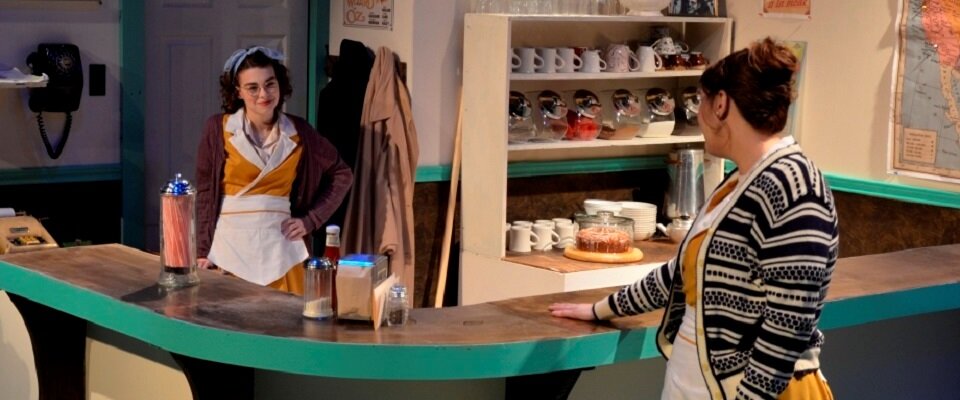“Just” a Technician - Part II
Here I continue to highlight the jobs done behind the scenes by our technicians who are so very essential to our success. Please remember, what you read here is just a basic overview of what these hard-working individuals actually do during the production season.
Costumes
In costuming, the designer will deliver the renderings and research to the costume shop manager and crew. They must then work together to pull items from stock, to rent from reputable warehouses, or to pattern and construct a new costume from scratch. Most of the time, it’s a combination of all three approaches at our university. Costumers’ work can also include dyeing, distressing, and altering. Every detail on a new build, from the fabric to the trim, from the buttons to the thread color, is carefully considered in conjunction with a production’s approach, the actor’s complexion, and the lighting and scenic designers’ mix of colors.
Costume renderings for the character of Hodel from Fiddler on the Roof. Costume designer, Samantha Pettigrew.
Drew Frazier as Perchik and Laramie Smith as Hodel in Fiddler on the Roof. Costume designer, Samantha Pettigrew.
The show is then handed off to the wardrobe crew who must plan, rehearse, and execute any quick changes that a play may demand. Nothing is scarier than an actor who misses an entrance because of a wardrobe malfunction, so great care is taken to ensure a timely and complete change.
Makeup, Hair and Wigs
Makeup, hair, and wigs collaborate with the other design areas, especially costumes, to complete the look for an ensemble. Once a designer has submitted drawings for each character, crews must work to fit the design to the theatre. Typically, less makeup is the norm for intimate spaces, while heavier makeup is used in larger venues. The designer and artists must work to balance foundation with the actor’s skin tone, execute special effects (which may include age, injury, or creature makeup), and master prosthetic additions like large noses or extended chins. Wigs must be built or styled from stock. And, if working with an actor’s natural hair, appointments are made during the rehearsal process to predetermine the preferred look.
Properties and Set Dressing
Typically overseen by the scenic designer, properties and set dressing involve both hand props and those items used to decorate the set. Often these demand extensive research, especially for period plays. Props are pulled from stock, borrowed from friends or family, purchased, or constructed from scratch. Property crew members must set up tables backstage where each prop is labeled and stored during a performance. Often props must be “tracked” as they change hands or make numerous exits and entrances in the course of a play. Additionally, the props crew is responsible for any perishable foods needed for a production. This may include cooking every night before a show as well as clean up after the performance has concluded.
Set dressing and props used to replicate a working diner for Bus Stop by William Inge. Directed by Laramie Smith. Scenic design by John Dement. Costumes design by Kaitlin de Graffenried. Pictured are actors Emory Lambert (as Elma) and Samantha Pettigrew (as Grace). For this production, the prop crew fried onions and bacon in the theatre on a portable hot plate prior to opening the house to enhance the experience.
Run Crew
Run crew (alternately called stage crew) are the individuals whose work is predominantly featured during the actual performances. They move set pieces and furniture, man the fly rails to raise and lower scenic drops, open and close the curtains, and operate any special effects equipment including fog machines or special trap doors for the set.
Publicity and Box Office
We take great pains at our university to make sure that all our promotional materials present the necessary information in a professional manner. This includes all our posters, programs (a good program can spark curiosity and conversation about the department), voicemails, websites, social media posts, and press releases. Our front-of-house staff has responsibilities that can include designing lobby displays, proofreading publicity materials, distributing posters, writing press releases, answering phone calls and emails from patrons, tabulating head counts, and totaling box office receipts. The box office crew—and by extension our house manager and ushers—are the first people our patrons encounter whether for reservations or for will-call pickup. Naturally, it’s important to us that our guests be treated with courtesy and professionalism. Positive word-of-mouth reviews about the entire experience are essential to our success.
Phew.
Let me close by saying that we do not believe in sexist assignments. Our female students learn to be confident carpenters and electricians, and our male students are expected to know how to handle a sewing machine and apply make-up. Sometimes, when a student faces a challenging assignment in an area they have little experience with, he or she stumbles upon a hidden talent. New confidence is found, new skills are discovered, and an opportunity avails itself for future employment.
I’m often at a loss for words when I look at how many different specializations there are in the world of theatre and how these individuals must all work together—with respect for each other’s gifts—to create something completely dependent upon the ensemble: so many talents working toward one goal.
-Traci Ledford


